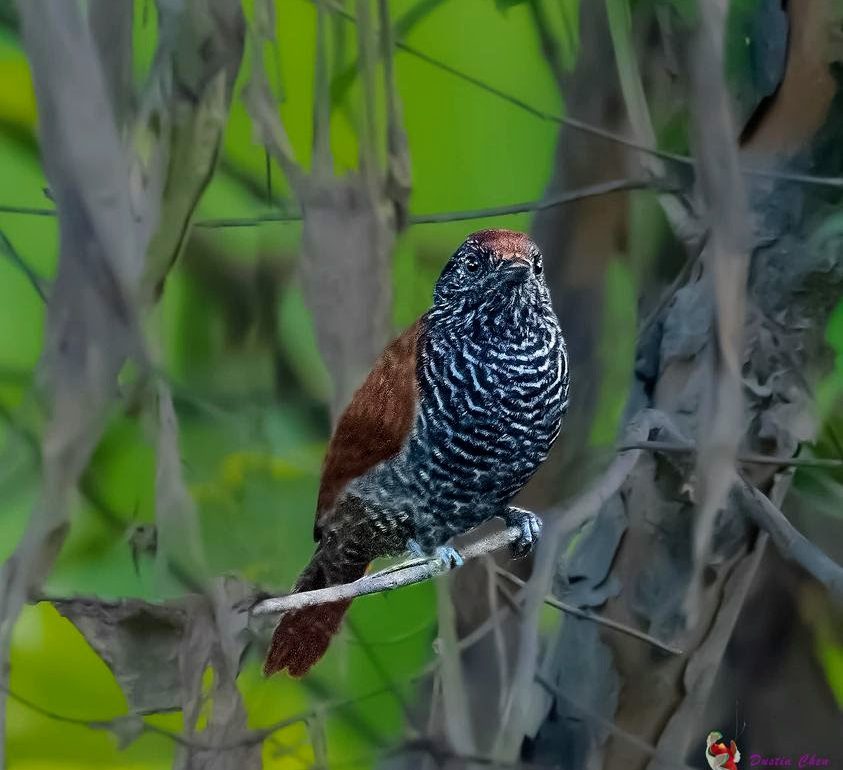
Have you ever birded a place so young that birds still have no names? Ten days ago, I was sitting in a boat in the Colombian Amazonia, listening to the chatter of numerous Large-billed Terns along a vast sandbank in the Rio Guaviare. The sunset was slowly blanketing the scene, making the water ever bluer and the forest deeper shaded. Then a group of birders appeared from the forest.
“At first we followed one trail, without success, then we followed the other one – the same happened – and when we were ready to enter the boat, to cross the river arm behind the sandbank, there it was, the bird with no name.” Discovered only in 2007 and photographed by Pablo Florez in 2016, in the latest field guide, the Lynx guide, this bird is literally called the “Unnamed Antshrike” (cover photo, a female by Dustin Chen).
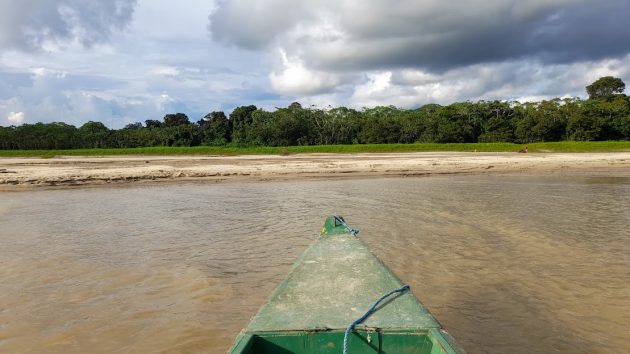
Thamnophilus sp. could be a separate and isolated population of the Chestnut-backed Antshrike (which lives more than a thousand kilometres away on the south bank of the Amazon in Brazil), as was initially thought, could also be a separate subspecies of it, but it is most likely to be a new species.
Oh, how I dreamed of exploring Amazonia as a little boy. And, as a part of growing up and getting “serious”, I forgot my childhood dreams. They were too childish, right?
To my utter surprise, thanks to Luis Urueña and Edson Moroni, one of those dreams came true: I have just returned to Belgrade from an absolutely incredible trip to the Colombian Amazonia as part of Manakin Nature Tours and ProColombia FAM trip. Dubbed the Escape to the Orinoco River Basin of Colombia, this one-week and 250-species long trip uses the riverside city of Inírida as a comfortable single-base to explore the unique mix of birds that occur in the Estrella Fluvial Ramsar site.
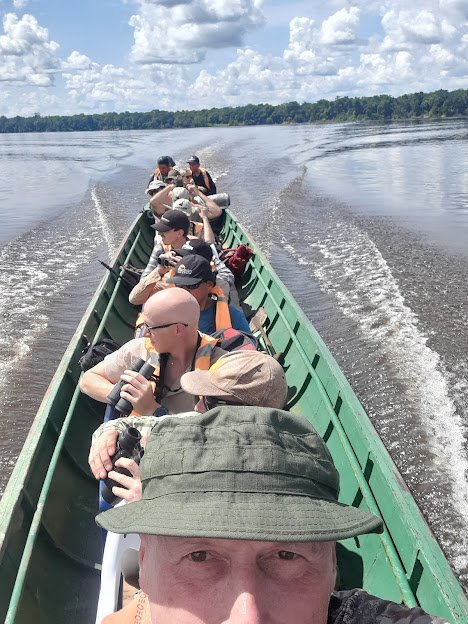
On July 8, 2014, the Colombian government declared this area as the Ramsar site Estrella Fluvial de Inírida – the River Star of Inírida. The River Star is the sixth Ramsar site in Colombia and the first in the Amazon. The declared area covers 253 thousand hectares, and it safeguards an important freshwater area in the border region with Venezuela, a transition zone between the Orinoquía and the Amazon, where three different rivers converge (Atabapo, Guaviare and Inirida) and flow into the Orinoco, the third most important river in the world by its volume of water. These multiple river confluences were described as the “river star” by none other than Alexander von Humboldt, who was exploring the area in the early 1800s.
The next morning, Manakin Nature Tours took us to the Matraca Trail (3mi/6hrs/85species), some 20 minutes by boat away from the port – possibly the best birding spot in the entire Inirida. It passes through diverse várzea habitats, consisting of forests and white-sand grasslands. The trail is about 4 km long, and it leads to the Matraca Community of the Curripaco indigenous people that live in the forest and survive on agriculture and fishing.
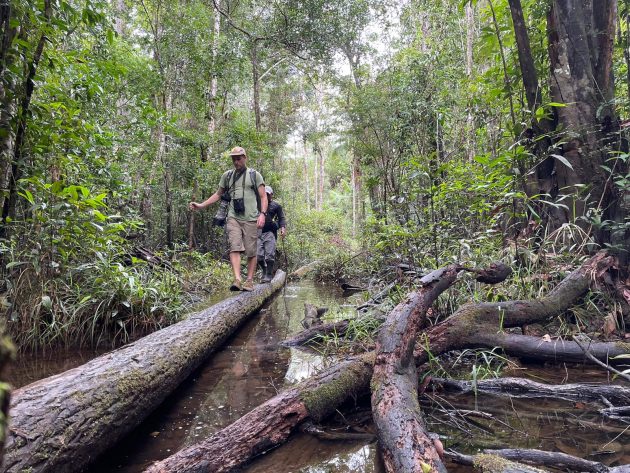 The Matraca Trail, photo Juan Carlos
The Matraca Trail, photo Juan Carlos
But, walking on crutches, I stayed at the beginning of the trail, before a steep slope that reaches a higher, flat section of the trail. There was a small river arm (Black-collared Hawk, American Pygmy and Green Kingfishers) and, above it, a fruiting tree that attracted birds all the time (Ivory-billed Aracari, Black-tailed and Green-backed Trogons, Thick-billed Euphonia, Masked Crimson and Turquoise Tanagers etc.). One of my dream-birds, the strangely yellow Cream-coloured Woodpecker awaited us on a nearby branch, then the Amazonian Umbrellabird flew over (at first I had no clue how it looks in flight, as that is not illustrated in the field guide, but the cooperative bird repeated the motion so my guide Edson Moroni pointed my attention to it) and finally, among vultures high in the sky, there were two King Vultures.
Soon the sun moved and my chair was now in bright sunlight, when some of the Curripacos working nearby came with half a dozen young saplings with large leaves, to create a shade for me. This act of kindness wasn’t the only one I experienced, as they always tried to make us feel more comfortable and more welcome. For example, what would you want on a hot day, apart from water? Pineapple, of course, so they shared a pineapple with us.
On our sail back, Large-billed Terns and Black Skimmers flew along, while Southern Lapwings stood at sand bars, together with numerous Sand-coloured Nighthawks, plus a few Common Nighthawks among them.
This Ramsar Site is located in the Orinoco – Amazon transition zone. It comprises the confluence zones of the rivers Inírida – Guaviare, Guaviare – Atabapo and Guaviare – Ventuari which join the Orinoco River. This is a unique area as its flooded forests belong to the Amazon biome while its ‘whitewater’, ‘blackwater’ and ‘clearwater’ hydrological ecosystems are characteristic of the Orinoco River. The River Star is home to more than 460 species of birds (60% of the bird species found in the Colombian Orinoquía), more than 470 fishes, 200 mammals, 40 amphibians and 1,172 species of plants.
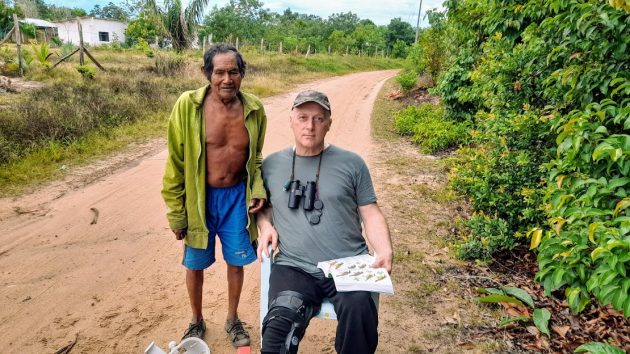
Estrella Fluvial also includes important cultural assets for the indigenous communities, 15 tribes belonging to the Puinave and Curripaco people, living there and depending on it for their livelihoods. Our tour organiser, Manakin Nature Tours, has been operating this Inirida tour for the last 6 years, supporting indigenous communities, local operators and local economy. Manakin also has an agreement with WWF regarding conservation, environmental education and research programs.
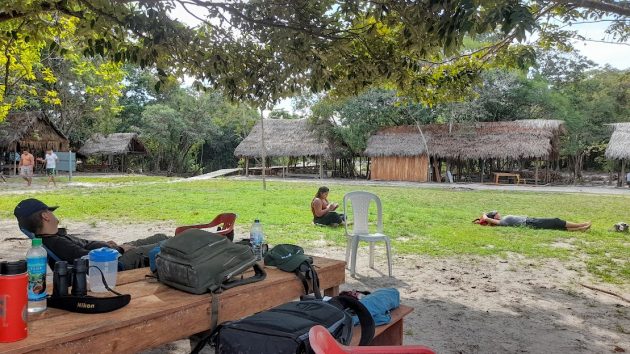
The Curripaco de Sabanitas Community, one of the best organised indigenous communities near Inirida, offers grassland and varzea trail (5mi/5hrs/80species) with a local bird guide and is the only place in the whole of Colombia where an iconic Capuchinbird can be found. Afterwards try swimming in clear but (literally) orange waters of a local river, followed by an excellent pescado moquiado lunch in a palm thatch shade. Fish is not just prepared and spiced magnificently, but also served on banana leaves, forcing even me to photograph it. Wherever you are, local fish is your best bet for an excellent meal (locally prepared fish was never just “good”, it was nothing less than excellent), but nowhere else is it served with so much style that you reach for your camera first and your fork second.
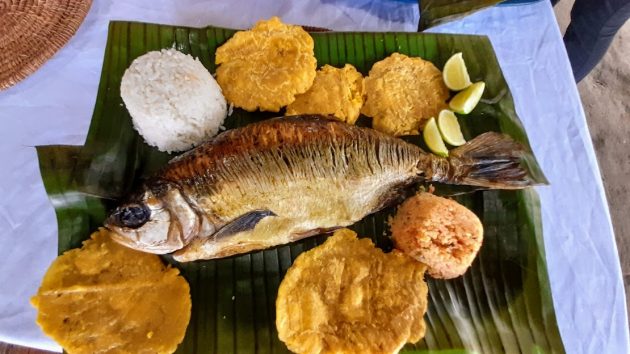
The road reaching Sabanitas moves through rural countryside where you may spot Yellow-tufted Woodpecker, Green-backed Trogon and White-throated Toucan among the palm-thatched houses, plus large Scarlet and enormous Blue-and-yellow Macaws feeding on fruit in the treetops. When you reach Sabanitas, Bare-Necked Fruitcrows and Glittering-throated Emeralds will be flying from tree to tree, Amazon Kingfishers will be eyeing prey in those orange waters, and even one of my tropical nemesis birds, a Sunbittern awaited us eating a fish.
Then, there were the kids. Once it became too hot for birding, Moroni and I sat in the shade, watching soaring vultures high in the sky, and the local kids playing at the river. At first there were two girls, the younger and cheekier one pushing her older friend from the bridge. Then both of them were at the top, getting ready to jump; only the younger stopped at the last moment, letting the older feel like a fool. Soon, the river was full of kids, some of them so young that I felt they could have used some adult supervision, yet they were not just great swimmers, but older kids were giving them supportive hugs in the water. I couldn’t help thinking: this is the way to grow up, not playing games in front of the computer screen.
– end of part 1 –
Find the part 2 of the tour here: https://www.10000birds.com/birding-inirida-colombia-or-river-dolphins-and-hoatzins-part-2.htm
Find the part 3 of the tour here: https://www.10000birds.com/birding-inirida-colombia-practicalities-part-3.htm
Cover photo: “Unnamed Antshrike”, a female by Dustin Chen













Excellent account! Really looking forward to take him birding into the land of the tepuis – table top mountains, in southern Venezuela, once the country is settled-down from its current crisis.
David Ascanio
Coauthor Birds of Venezuela (2017). Helms Field Guide.
Core Leader.
Víctor Emanuel Nature Tours.
What an amazing place! Thanks for a fabulous story about wonderful birds and people. I want to jump on a plane and go there today.
Thank you, Wendy. Having 8 in of snow in front of my window, I sure feel like going back this very evening.
Thank you, David, I’m ready and waiting 🙂
What a great trip! Sounds fantastic Dragan, I’m happy for you and look forward to reading more about it.
I am going to Inirida in March, 2024. I was excited about going to this region before reading your account of your time there. Now I am triple excited to see this place. Thank you for your blog.
Bon voyage, Dennis, just now I re-read my Inirida posts, what a place that is!
Enjoy your trip – I am envious! Feel like repeating it but in the rainy season 🙂